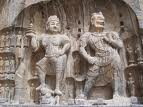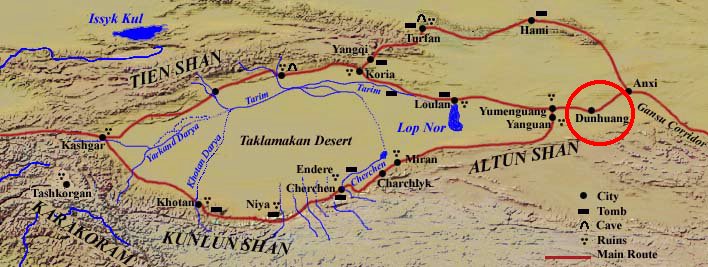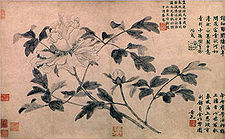
Silk Road Trade & Travel Encyclopedia
丝绸之路网站(丝路网站)
丝绸之路百科全书—游客、学生和教师的参考资源
İPEK YOLU ve YOLLARI ANSİKLOPEDİSİ
www.ipekyollari.net

Silk Road Trade & Travel Encyclopedia
丝绸之路网站(丝路网站)
丝绸之路百科全书—游客、学生和教师的参考资源
İPEK YOLU
ve YOLLARI
ANSİKLOPEDİSİ
www.ipekyollari.net
L
A B
C
D
E
F
G
H I
J
K
L
M
N O P
Q
R
S
T
U V
W
X
Y
Z
Lamaism (Tibetan Buddhism) is the body of Buddhist religious doctrine and institutions characteristic of Tibet and Northeast China, and certain regions of the Himalayas, including northern Nepal, Bhutan, and India It is also practiced in Mongolia and parts of Russia.
Lamasery Numerous ritual sites and temples (also known as a "lamasery") can by visited along the Silk Routes. The Bingling Lamasery, which has a history of over 1,500 years, comprises grottoes of 2 kilometers and is built in 4 layers into the steep cliff of a mountain. The temple houses 183 grottoes, nearly 800 statues, and about 900 square meters of frescoes. The Labrang Lamasery, which was built in 1709, is one of the six largest religious temples of the Gelug Sect of China's Lamaism, second only to the Potala Palace in Lhasa, Tibet. The lamasery covers 82 hectares and has more than 10,000 halls and accommodates over 3,000 lamas.
Land of Punt The exact location of the Land of Punt remains a mystery. Most scholars today believe Punt was located to the south-east of Egypt, most likely on the coast of the Horn of Africa in what is today northern Somalia. However some scholars point instead to a range of ancient inscriptions which locate Punt in Arabia. Frankincense and myrrh were traded after coming both by sea and overland trade routes through the mountains running north along the east coast of the Red Sea. This trading center was known for producing and exporting gold, aromatic resins, African blackwood, ebony, ivory, slaves and wild animals. Information about Punt has been found in ancient Egyptian records of trade missions to this region. In the Eighteenth dynasty of Egypt c.1550-c.1292 BCE, Hatshepsut built a Red Sea fleet to facilitate trade between the head of the Gulf of Aqaba and points south as far as Punt
Lanzhou This was a major trading hub for merchants from Mongolia, Sichuan and Tibet. Here, caravans from the west met the Yellow River. In 81 BC, under the Han dynasty (206 BC–220 AD), Lanzhou became the seat of Jincheng county and later of Jincheng commandery, the county being renamed Yunwu. The city used to be called the Golden City, and since at least the first millennium BC was a major link on the ancient Northern Silk Road, and also an important historic Yellow River crossing site. To protect the city, the Great Wall of China was extended as far as Yumen. In the late thirteenth century, Marco Polo spent an entire year in Lanzhou. Lanzhou is the capital of Gansu Province in northwestern China. The "Hexi Corridor" is located nearby (historically the only route from central China to western China and the rest of Central Asia).
Lapis Lazuli is a relatively rare semi-precious stone that has been prized since antiquity for its intense blue color. Lapis lazuli has been mined from mines in the Badakhshan province of Afghanistan for over 6,000 years and there are sources that are found as far east as in the region around Lake Baikal in Siberia. Trade in the stone is ancient enough for lapis jewelry to have been found at Predynastic Egyptian sites, and as lapis beads at neolithic burials in Mehrgarh, the Caucasus, and even as far from Afghanistan as Mauritania. In ancient Egypt lapis lazuli was a favorite stone for amulets and ornaments such as scarabs; it was also used by the Assyrians and Babylonians for seals. Lapis jewelry has been found at excavations of the Predynastic Egyptian site Naqada (3300–3100 BC).
Le Coq
Albert von Le Coq A German archaeologist who at the beginning of the 19th
century took part with other foreign explorers from the West to find and obtain
enormous quantities of wall-paintings, sculptures, manuscripts, and other
treasures from China and the ancient cities of the Silk Routes. (See Peter
Hopkirk) More...
Lei Yin Si temple is located 4 km south of Dunhuang, in Gansu China.
Levent ("the Levent") The countries bordering on the eastern Mediterranean Sea from Turkey to Egypt. Levant was originally applied to the "Mediterranean lands east of Italy", from the Middle French word levant meaning "the Orient". Historically, the "trade on the Levant" between Western Europe and the Ottoman Empire was of great economic importance. More...
Liang
Yeh-lü Hi Liang (1260-1263) Great-grandson of Yeh-lü Ch'u-ts'ai, who along with his
father, worked for Möngke Khan and then Qubilai. His biography in the Yüan-shi
relates his travels in Inner Asia in the period of the Mongol civil war prior to
Qubilai's consolidation of power.
Linxia Frequented by pilgrims, Linxia played an important role in the spread of Islam from Central Asia to China. About two dozen mosques can be found throughout the city, including Nanguan mosque which features both Chinese and Arabic architectural details. More...

Lo
Yung Lo In 1417, a Chinese embassy arrived at Shah Rukh’s court with a
letter from the third emperor of China's
Ming Dynasty,
Yung Lo, along with lavish presents. The letter stated that the Ming
emperor and the Timurid sultan should "lift the veil of difference and disunity
and order the opening of the door of agreement and unity, so that subjects and
merchants may come and go at will, and the roads may be secure.” Yung Lo is also
responsible for leading large armies north to the Gobi Desert,
forestalling the creation of a Mongol confederation that might have threatened
China. It was also under his reign that China's capital was transferred from
Nanjing to Beijing, the
Forbidden City was built, and
Grand Canal repaired.
Longjumeau
Andrew of Longjumeau (c. 1250) A Dominican and papal envoy to the Mongols,
traveled from the Holy Land to the vicinity of Tabriz (N. Iran) on his first trip.
On the second, accompanied by several others including his brother William, he went
much farther (his route is not well documented) to the inner Asian dominions of
the Mongols, where he arrived during the regency of Oghul Qaimish, the widow of
Khan Güyüg. His journeys are included in the summaries of Matthew Paris's
Chronica Majora.
Longmen Grottoes In addition to the best known grottoes near the region of the Silk Road, known as the Mogao Caves, the Longmen Grottoes are one of the three most famous ancient sculptural sites in China. The distance covered by grottoes is about one km. There are over 2,100 niches, more than 100,000 statues, some 40 pagodas and 3,600 tablets and steles in the caves of Guyang, Binyang and Lianhua. More...

Looting (valuables pillaged in time of war) has been a part of the history of the Silk Routes. The subject is still a topic of debate, mainly over which items were unjustly and illegally taken, or looted. Looting is a term which can be generally used, such as during the crusades, or when the city of Samarkand was conquered by Genghis Khan. After the 19th century expeditions by Sven Hedin of Sweden (and later Sir Aurel Stein of Britain, Paul Pelliot of France, Albert von Le Coq and Albert Grunwedel of Germany) an archaeological race of excavations resulted in looting of historic Silk Road sites (many cases around the world have not been legally resolved). The problem of looting and illegal trade of artifacts is an ongoing international issue, made even more complex due to global events such as natural disasters and warfare (i.e. looting of the National Museum in Baghdad, Iraq). The prevention of looting and rioting is a modern-day security issue. (The words booty, spoils and plunder are also used to describe items captured by raiding and conquest). More...
Lop Nur (Lop Nor, Qakilik, Bayingolin, China) A strategic pass of the ancient Silk Routes of northwest China. It is now a marshy depression, and once was a large salt lake at the east end of the Tarim Basin in northwest China. The former lake ceased to exist by about 1970, after irrigation works and reservoirs were completed on the middle reaches of the Tarim River, one of its former tributaries. Lop Nur lies within the Tarim Basin of the eastern Taklamakan Desert, in the Uygur Autonomous Region of Xinjiang, and is one of the most barren areas of China.

As the Silk Routes extend westward from the ancient commercial centers of China, they divide into the northern and southern routes bypassing the Taklamakan Desert and Lop Nur.
Loulan (ancient Kroran, or Shanshan) Loulan was an ancient state in the Lop Nur desert which was established as a kingdom in 176 BC, and flourished for over 800 years. As one of the major stops in Xinjiang on the old Silk Road, the city was a center for trading. Ruins of ancient Loulan are located about 300 km northeast of Ruoqiang, in the Bayingolin Mongol Autonomous Prefecture of Xinjiang, China. One of the great mysteries in Chinese history is the disappearance of the ancient city of Loulan. The world-famous ruins of the Loulan Kingdom seem to have been swallowed up by the shifting sands of the Taklamakan Desert 1,400 years ago. Loulan was the capital of the 36 kingdoms in the western region of the Han Dynasty, as well as an important thoroughfare on the ancient Silk Road, and flourished from the 2nd century B.C. to the 4th century. Loulan was situated along the sole route from the Central Plains to the south route of the Western Regions during the Han Dynasty, and played a very important role in the cultural exchanges between the East and West. Artifacts from the ruins have attracted worldwide attention, including the hand-written copy of the Strategies of the Warring States Period. The ancient city of Haitou and the ruins of Miran are south of Loulan. The ancient city of Qiemo is to the west. More...
Luntai During the Tang Dynasty, 648 AD, the Tang government set up the town of Luntai in the ancient town of Urabo, about 10 kilometers from present-day Urumqi. Luntai was a seat of local government and location where taxes were collected from the caravans along the northern route of the Silk Road.
Luoyang (Henan Province China) is situated east of the city of Xi'an, which is often referred to as beginning of the Silk Road. During the Han Dynasty (25-220 AD) Luoyang was known as a city of the Silk Road The city alternated with Xi'an (Chang'an) as the Chinese capital during the first through fifth centuries. Luoyang is a considered a cradle of Chinese civilization. The Longmen Grottoes were listed by UNESCO in the list of World Heritage Sites in November 2000. Other sites of interest include the White Horse Temple, a series of temples that were built in honor of Guan Yu (a hero of the Three Kingdoms period), and the tombs museum Luoyang Ancient Tombs Museum, the Luoyang Museum. Luoyang is famous for its peonies, one of China’s floral exports, and the city flower of Luoyang. The peony is among the oldest depicted flowers in ornamental art. Luoyang holds an annual Peony Festival to celebrate its indigenous flower.

Peony, by Chinese artist Wang Qian, Yuan Dynasty (1271–1368)
Silk Routes.net | Ipek Yollari.net